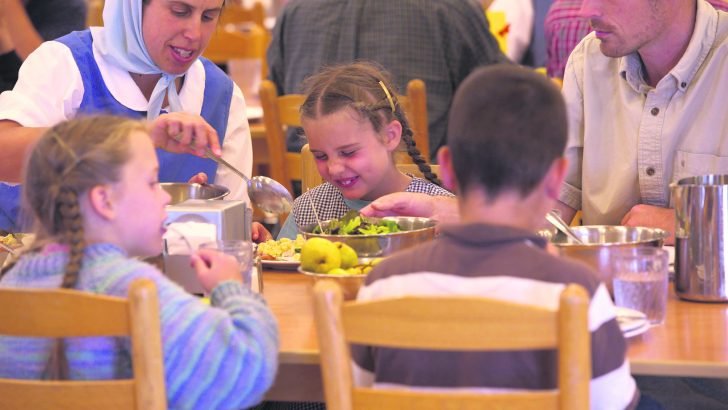The Bruderhof community is an oasis of sanity in our world, writes David Quinn
A small, little known religious community called the Bruderhof has been gaining a bit of attention lately because of an upcoming documentary about them that is to air on the BBC. The community consists of about 3,000 members spread across 23 locations in five different countries. They try to live the Christian life radically, that is, as described in the Acts of the Apostles. They are an extremely interesting “experiment in living”, to use the words of English philosopher, John Stuart Mill, a founder of modern liberalism.
I first came across them in 2014 at a conference held at the Vatican. Their then leader, Johann Christoph Arnold, addressed the gathering. He was the grandson of its founder, Eberhard Arnold.
The Bruderhof, as the name implies, seek to live in a brotherly way. They take literally the passages from Acts which describe how the early Christians “held all things in common. They sold their possessions and property and distributed the proceeds to all, as anyone had a need”.
In some ways, they are quite like the Amish, except that they are more open to technology, and while the women wear distinctive garb (small scarves on their heads and long skirts), the men do not. Their theology is Protestant and specifically Anabaptist, which was one of the most radical Protestant groups that originated in Germany during the Reformation. Baptists and Anabaptists do not believe in infant baptism and their style of worship is plain. Ritual, sacraments and hierarchy are de-emphasised, making them ‘low Church’.
Members of the Bruderhof literally own no private property. Families do have apartments of their own, but they share their kitchen with the family next door. They eat communally every day.
Bruderhof communities support themselves financially through their successful businesses which make and sell mainly furniture. The money generated goes into a common pot and members receive what they need from this central fund, in other words “as anyone has a need”.
Gender roles are mostly traditional, in that women do more of the domestic work than men, while men work mainly in the factories making furniture. But women work on the sales and clerical side of their businesses and some are dentists, nurses etc. to their communities.
Interestingly, mothers return to work when their babies are only a few months old and the babies are put into creches during the day. This sounds quite like what a lot of parents feel obliged to do today in society in general, but the emphasis again is on communal living, and obviously the care-givers for the babies and small children will be very familiar, constant faces. This is quite unlike most modern creches which often have a high turn-over of staff and the care-givers are not drawn from the same small, tight community as the parents.
The Bruderhof were founded in 1920 in Germany partially as a response to the post-World War I crisis in Germany. Communism was growing in appeal and Eberhard Arnold wondered if there was a Christian way of rejecting capitalism. He found an obvious answer in the Acts of the Apostles: live communally and share everything in common. A great deal of Bruderhof writing is very critical of capitalism.
At bottom, what they are rejecting is a materalism and consumerism that gives too much prominence in our lives to material acquisition and status based on what we own.
One of the chief aims of the Bruderhof is to try and remove competition as the basic drive in our lives”
In fact, it seems to me that one of the chief aims of the Bruderhof is to try and remove competition as the basic drive in our lives because competition is too often about acquiring power and rank and dominance over others which ought to be the antithesis of the Christian life.
Even the way the men and women dress plainly is part of that. How we dress and present ourselves can also be a form of competition, a way of projecting status and telling others that we are better than them. The simple way the women in particular present themselves – their garb and lack of make-up – isn’t far off how nuns in the Catholic tradition present themselves also, or for that matter, feminists who believe that an over-emphasis on appearance can become a trap for women.
Earlier in the article I described the Bruderhof as an “experiment in living”. Religious communities have for centuries been experiments in living, showing an alternative way of life. Within Catholicism that has usually led to the formation of convents and monasteries based on the three vows of chastity, poverty and obedience.
But Catholics have much more rarely formed communities of families whose lives are also, in effect, based on vows (even if not formally taken) of chastity, poverty and obedience.
For me it is fascinating to see how this works when groups of families (which is what Bruderhof communities are at bottom) seek to live in a way that is so radically at variance with how the vast majority of us – Christians included – live our lives. We are very dominated day-to-day by structures of power and material acquisition and competition and status in ways we barely even notice.
The upcoming BBC documentary has, as mentioned, caused quite a lot of commentary already, some of it critical, likening the Bruderhof to a ‘cult’ and focusing attention on the mainly traditional gender roles and the garb of the women.
But how must society in general look to them with our rampant consumerism, addiction to smart phones, the growing number of children suffering from anxiety or depression, our high divorce and abortion rates, crime, drug and alcohol abuse and so on? Compared with that, they are an oasis of sanity. We should be thankful they exist.


 David Quinn
David Quinn